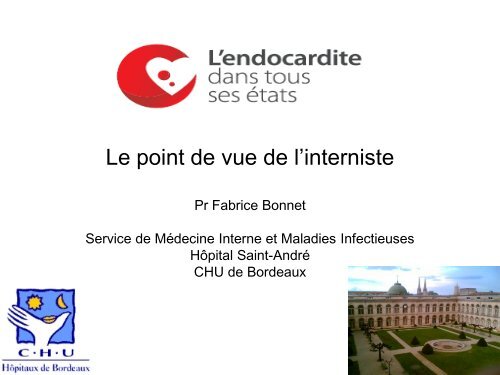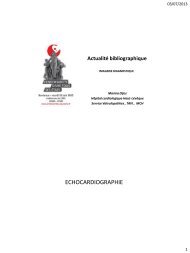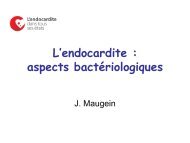Le point de vue de l'interniste - Endocardites Aquitaine
Le point de vue de l'interniste - Endocardites Aquitaine
Le point de vue de l'interniste - Endocardites Aquitaine
You also want an ePaper? Increase the reach of your titles
YUMPU automatically turns print PDFs into web optimized ePapers that Google loves.
<strong>Le</strong> <strong>point</strong> <strong>de</strong> <strong>vue</strong> <strong>de</strong> l’interniste<br />
Pr Fabrice Bonnet<br />
Service <strong>de</strong> Mé<strong>de</strong>cine Interne et Maladies Infectieuses<br />
Hôpital Saint-André<br />
CHU <strong>de</strong> Bor<strong>de</strong>aux
Sir William Osler<br />
• 12/07/1849 – 19/12/1919<br />
• Mé<strong>de</strong>cin canadien<br />
• A exercé au Canada, Etats-<br />
Unis et Angleterre<br />
• Considéré comme le père <strong>de</strong><br />
la mé<strong>de</strong>cine Mo<strong>de</strong>rne<br />
• Mé<strong>de</strong>cin, clinicien, anatomopathologiste,<br />
enseignant,<br />
bibliophile, historien,<br />
conférencier, organisateur,<br />
auteur
The Four Doctors <strong>de</strong> John Singer Sargent<br />
en 1905, représentant les quatre<br />
mé<strong>de</strong>cins qui ont fondé l’Hôpital Johns<br />
Hopkins. L'œuvre originale est exposée à<br />
la Bibliothèque médicale William H. Welch<br />
<strong>de</strong> l’Université Johns-Hopkins.<br />
De gauche à droite: William Henry Welch,<br />
William Stewart Halsted, Osler, Howard<br />
Kelly Atwood<br />
• Naissance à Bond head dans l’Ontario<br />
• Université <strong>de</strong> Trinitry College à Toronto<br />
puis Mc Gill <strong>de</strong> Montréal<br />
• Diplôme <strong>de</strong> mé<strong>de</strong>cine en 1872<br />
• Formation post-universitaire en Europe<br />
• Nommé professeur en 1874, il crée alors le<br />
premier « Journal Club »<br />
• 1884 : chaire <strong>de</strong> mé<strong>de</strong>cine clinique à<br />
l’université <strong>de</strong> Pennsylvanie<br />
• 1889 : premier mé<strong>de</strong>cin chef <strong>de</strong> l’hôpital<br />
Johns Hopkins<br />
• 1893 : premiers prof <strong>de</strong> l’université du<br />
même nom<br />
• 1905 : doyen <strong>de</strong> l’université d’Oxford<br />
• 1901-1904 : 2ème prési<strong>de</strong>nt <strong>de</strong> la Medical<br />
Library Association<br />
• Créateur du programme <strong>de</strong> formation <strong>de</strong>s<br />
résidants et internes en mé<strong>de</strong>cine!<br />
……du système <strong>de</strong> gar<strong>de</strong><br />
……et <strong>de</strong> la structure pyramidale <strong>de</strong> l’hôpital!
« The four <strong>point</strong>s of<br />
a medical stu<strong>de</strong>nts’<br />
compass are :<br />
Inspection<br />
Palpation<br />
Percussion<br />
Auscultation »<br />
« Si vous écoutez<br />
attentivement le<br />
patient, il vous<br />
donnera le diagnostic<br />
»
« Je ne désire pas d’autre épitaphe… sinon<br />
la déclaration que j’ai enseigné aux<br />
étudiants en mé<strong>de</strong>cine au lit du mala<strong>de</strong> et<br />
que je considère cela comme étant <strong>de</strong> le<br />
travail le plus utile et le plus important que<br />
j’ai été amené à faire »
<strong>Le</strong> nom d’Osler dans le langage<br />
courant<br />
<strong>Le</strong> signe d’Osler est une Pression artérielle anormalement élevée en raison <strong>de</strong> la<br />
calcification <strong>de</strong>s Artères (athérosclérose).<br />
<strong>Le</strong>s nodules d’Osler sont <strong>de</strong>s nodules apparaissant sur la pulpe <strong>de</strong>s doigts ou <strong>de</strong>s<br />
orteils, une vascularite auto-immune qui est évocatrice d’une endocardite bactérienne<br />
subaiguë.<br />
La Maladie <strong>de</strong> Rendu-Osler (également connue sous le nom <strong>de</strong> télangiectasies<br />
hémorragiques héréditaires ).<br />
Maladie d’Osler-Vaquez (également connue sous le nom <strong>de</strong> polyglobulie <strong>de</strong> Vaquez)<br />
La manœuvre d’Osler: consiste à rechercher une artère radiale palpable, bien que<br />
sans pouls chez un patient lorsque le brassard est gonflé au-<strong>de</strong>ssus <strong>de</strong> la pression<br />
systolique<br />
<strong>Le</strong> syndrome d’Osler est un syndrome comportant <strong>de</strong>s épiso<strong>de</strong>s récurrents <strong>de</strong><br />
douleur colique, avec <strong>de</strong>s irradiations typiques vers l’arrière, un état grippal et <strong>de</strong> la<br />
fièvre, en raison <strong>de</strong> la présence dans l’ampoule <strong>de</strong> Vater d'un calcul mobile plus<br />
grand que l'orifice biliaire.<br />
La tria<strong>de</strong> d’Osler: association d’une pneumonie, d’une endocardite, et d’une<br />
méningite.<br />
Sphryanura osleri est un ver trémato<strong>de</strong>s retrouvé dans les branchies d'un triton.
L’ENDOCARDITE SUBAIGUE D’OSLER
L’endocardite<br />
Infectieuse<br />
<strong>vue</strong> par l’interniste
L’endocardite <strong>vue</strong> par l’interniste<br />
La FUO<br />
• Une cause habituelle <strong>de</strong> FUO<br />
« Fever of Unknown Origin »<br />
– Evolution <strong>de</strong>puis plus <strong>de</strong> 3 semaines<br />
– Température supérieure à 38°3 C (101°F) à<br />
plusieurs reprises et confirmée médicalement<br />
– Diagnostic incertain après 1 semaine<br />
d’hospitalisation
Année<br />
1961<br />
1982<br />
1984<br />
1991<br />
1992<br />
1994<br />
1997<br />
Nb <strong>de</strong> cas<br />
100<br />
105<br />
133<br />
199<br />
85<br />
153<br />
167<br />
%<br />
Infections<br />
36<br />
30<br />
31<br />
23<br />
13<br />
29<br />
26<br />
abdominale<br />
4<br />
10<br />
3<br />
2<br />
0<br />
0<br />
1<br />
hépatobiliaire<br />
7<br />
1<br />
2<br />
1<br />
0<br />
0<br />
1<br />
endocardite<br />
5<br />
0<br />
2<br />
2<br />
0<br />
3<br />
2<br />
tuberculose<br />
11<br />
5<br />
11<br />
5<br />
10<br />
7<br />
2<br />
CMV<br />
0<br />
4<br />
0<br />
4<br />
0<br />
1<br />
3<br />
Néoplasies<br />
20<br />
31<br />
18<br />
7<br />
29<br />
17<br />
13<br />
hématologiques<br />
8<br />
21<br />
12<br />
3<br />
16<br />
11<br />
8<br />
LMNH<br />
6<br />
16<br />
12<br />
1<br />
14<br />
9<br />
7<br />
tumeurs soli<strong>de</strong>s<br />
9<br />
10<br />
5<br />
4<br />
13<br />
5<br />
4<br />
Inflammatoires<br />
17<br />
10<br />
14<br />
21<br />
31<br />
30<br />
23<br />
Lupus<br />
5<br />
0<br />
1<br />
1<br />
0<br />
2<br />
1<br />
Still<br />
2<br />
4<br />
1<br />
3<br />
5<br />
10<br />
4<br />
Horton<br />
1<br />
2<br />
4<br />
9<br />
12<br />
3<br />
3<br />
Sarcoidose<br />
2<br />
2<br />
0<br />
2<br />
0<br />
1<br />
1<br />
Medicamenteuse 1 0 0 3 0 2 2<br />
Factice 3 3 5 4 4 3 1<br />
Autre 15 9 10 15 6 9 6<br />
Sans diagnostic 9 16 22 26 18 12 30
Fièvre > 38°3 pdt > 20j sans diagnostic<br />
Antécé<strong>de</strong>nts<br />
Traitements<br />
Histoire<br />
Examen clinique<br />
-<br />
Fièvre nue sans orientation<br />
Bilan <strong>de</strong> base : bilan inflammatoire, hemoc, ECBU, sérologies<br />
virales et bactériennes, radio, échographie abdo-pelvis<br />
Second Bilan : ETO, Scanner TAP, biopsies, endoscopies,<br />
scintigraphies, imagerie cérébrale
L’endocardite <strong>vue</strong> par l’interniste<br />
Manifestations extracardiaques<br />
• Signes généraux<br />
– Pas d’endocardite sans fièvre<br />
– Splénomégalie 25 à 60%<br />
• Signes cutanés…. 5-15%<br />
et complications<br />
• Signes rhumatologiques<br />
– Arthralgies 40%<br />
– Arthrites septiques ou immunologiques 20%<br />
– Myalgies, myosites 20%<br />
• Signes respiratoires 25-40%<br />
– Toux isolée<br />
– Infiltrats, abcès, épanchements pleuraux<br />
• Embolies septiques 30%<br />
– Abcès profonds…sites multiples et variées…
L’endocardite <strong>vue</strong> par l’interniste<br />
Des localisations septiques
L’endocardite <strong>vue</strong> par l’interniste<br />
Complications neurologiques 20-40%<br />
– Staphylocoque (50-70%)<br />
– Mécanisme<br />
• Embols septiques/Infarctus/abcès<br />
• Vascularite, anévrysme mycotique,<br />
hémorragie<br />
– Dans 1/3 <strong>de</strong>s cas après l’initiation<br />
<strong>de</strong> l’antibiothérapie<br />
– Inaugurales dans 10-20% <strong>de</strong>s cas
L’endocardite <strong>vue</strong> par l’interniste<br />
<strong>Le</strong>s anévrysmes mycotiques
L’endocardite <strong>vue</strong> par l’interniste<br />
Complications rénales 50%<br />
• Localisations septiques<br />
• Vascularites/infarctus<br />
• Glomérulonéphrites à immuns complexes<br />
– GN focale et segmentaire<br />
– Prolifération endocapillaire<br />
– GN membrano-proliférative<br />
Prolifération endocapillaire<br />
Dépôts sous-endothéliaux
L’endocardite <strong>vue</strong> par l’interniste<br />
ou l’ophtalmo!<br />
<strong>Le</strong>s Nodules <strong>de</strong> Roth < 5%<br />
Hémorragies<br />
conjonctivales
<strong>Le</strong>s endocardites sont elles<br />
toujours infectieuses
<strong>Le</strong>s endocardites sont elles<br />
toujours infectieuses<br />
• Emanuel Libman 1872-1946 New York<br />
• Columbia University puis formation en Europe<br />
• Généraliste<br />
• <strong>Le</strong>gendaire par ses métho<strong>de</strong>s brusque et non orthodoxe!<br />
Excentrique et solitaire<br />
• Patients : Albert Einstein, Thomas Mann<br />
• Enseignant à Columbia University à partir <strong>de</strong> 1909<br />
• …. Un peu le Dr House <strong>de</strong> l’époque!<br />
• Benjamin Sacks<br />
• 1896-<br />
• Elève <strong>de</strong> Libman<br />
1 ère <strong>de</strong>scription en 1924 <strong>de</strong> l’endocardite au cours du LES<br />
Libman E, Sacks B: A hitherto un<strong>de</strong>scribed form of valvular and mural<br />
endocarditis.; Arch Intern Med 1924; 33: 701-37.
L’endocardite <strong>de</strong> Libman-Sacks<br />
• Végétations non infectieuses principalement<br />
développées sur la valve mitrale mais<br />
également au dépend <strong>de</strong>s autres valves, piliers<br />
et cordages.<br />
• Formations ovoï<strong>de</strong>s <strong>de</strong> 1-4 mm <strong>de</strong> diamètre<br />
constitué <strong>de</strong> tissus valvulaire, dépôt <strong>de</strong> fibrine et<br />
<strong>de</strong> thrombus plaquettaire.<br />
• Expose +++ au risque d’endocardite infectieuse<br />
• Prévalence 30-50% sur <strong>de</strong>s séries<br />
autopsiques
• Autopsy image<br />
<strong>de</strong>monstrates the<br />
clusters of numerous<br />
small vegetations on<br />
the ventricular surface<br />
of the aortic valve<br />
(white arrows) and<br />
multiple small<br />
vegetations on the<br />
atrial surface of the<br />
mitral valve (green<br />
arrows).<br />
Images in cardiovascular medicine. Numerous small vegetations revealing<br />
Libman-Sacks endocarditis in catastrophic antiphospholipid syndrome.<br />
Yamamoto H, Iwa<strong>de</strong> T, Nakano R, Mohri M, Amari Y, Noma M.<br />
Circulation. 2007 Nov 13;116(20):e531-5.
L’endocardite <strong>de</strong> Libman-Sacks<br />
• Prévalence <strong>de</strong> l’atteinte en echocardiographie = 11%<br />
<strong>de</strong>s 342 patients atteints <strong>de</strong> Lupus <strong>de</strong> la série <strong>de</strong><br />
Moyssakis (Am J Med 2007 ; 120 : 636)<br />
– 24/38 avec une atteinte mitrale (épaississement avec fuite<br />
constante + stenose chez 9 patients)<br />
– 13/38 avec atteinte aortique (fuite chez 11 and 8 avec sténose)<br />
• Augmentation du risque thrombotique (15% vs 3%<br />
durant le suivi)
Demographic, clinical and lab characteristics of patients with SLE with<br />
and without libman-sacks vegetations (Moyssakis et al, Am J Med 2007)<br />
Characteristics<br />
Patients with<br />
libman-Sacks<br />
N=38<br />
Patients without<br />
Libman-Sacks<br />
N=304<br />
OR<br />
P value<br />
Age 43,1 38,7 1,03 0,76<br />
Women 76% 88% 0,18<br />
Disease duration (Y) 13,1 5,9 1.19 0,001<br />
ECLAM 6,9 3,8 1,15 0,003<br />
Thrombose art ou<br />
veineuse<br />
43% 11% 3,88 0.01<br />
Péricardite 50% 11% 8,36 0.001<br />
Antiphospholipi<strong>de</strong>s 41% 4% 3,85 0,006<br />
Thrombopénie 48% 12% 6,42 0,001
L’endocardite <strong>de</strong> Libman-Sacks<br />
• Echographie transoesophagienne plus sensible pour le<br />
dépistage <strong>de</strong> l’endocardite <strong>de</strong> LS (J Rheumatol 2008)<br />
• Association étroite <strong>de</strong> l’endocardite <strong>de</strong> LS avec l’activité<br />
du LES et la présence d’APL<br />
• Prévalence supérieure <strong>de</strong> l’endocardite <strong>de</strong> LS dans le<br />
LES-APL que dans le syndrome primaire <strong>de</strong>s APL (Am J<br />
Med 1994)<br />
• Risque thrombo-embolique majeur<br />
• Prise en charge thérapeutique difficile<br />
– Problématique <strong>de</strong> la différenciation endocardite <strong>de</strong> LS-<br />
/Endocardite infectieuse<br />
– Corticothérapie impliquée dans <strong>de</strong>s cas d’aggravation <strong>de</strong><br />
l’endocardite<br />
– Immunosuppression et anticoagulation
<strong>Le</strong>s endocardites sont elles<br />
toujours infectieuses<br />
• Wilhelm Löffler 1887-1972, Suisse<br />
• Etu<strong>de</strong>s à Genève et en Europe<br />
• Professeur <strong>de</strong> Mé<strong>de</strong>cine en 1921<br />
• Directeur <strong>de</strong> l’Université <strong>de</strong> Zurich<br />
• Un <strong>de</strong>s premier à promouvoir la RP et à utiliser<br />
l’insuline!<br />
Décrit en une nouvelle entité : l’endocardite fibroplastique à éosinophiles<br />
W. Löffler. Endocarditis parietalis fibroplastica mit Bluteosinophilie. Ein<br />
eigenartiges Krankheitsbild. Schweizerische medizinische Wochenschrift,<br />
Basel, 1936, 66: 817-820.
L’endocardite fibroplastique <strong>de</strong> Loeffler<br />
• Cardiopathie à éosinophile survenant au cours<br />
<strong>de</strong>s syndromes hyperéosinophiliques<br />
• L’endocardite <strong>de</strong> Loeffler = thrombus à<br />
éosinophile, sta<strong>de</strong> précoce <strong>de</strong> la fibrose<br />
endomyocardique <strong>de</strong> la cardiopathie à<br />
éosinophiles.<br />
• 1 ère cause <strong>de</strong> DC au cours <strong>de</strong>s SHE<br />
• Prévalence <strong>de</strong> 50 à 75% <strong>de</strong>s cas selon les<br />
gran<strong>de</strong>s séries<br />
• Présentation clinique<br />
– Insuffisance cardiaque<br />
– Insuffisance valvulaire mitrale ou tricuspidienne
L’endocardite fibroplastique <strong>de</strong> Loeffler<br />
Mobile mass<br />
An apical four-chamber view of the<br />
heart shows a mobile mass attached<br />
to the basal septal wall in the left<br />
ventricle.<br />
Endomyocardial-Biopsy Specimens<br />
(Hematoxylin and Eosin).<br />
A high-magnification view of the<br />
myocardium shows prominent infiltration<br />
with eosinophils (arrows) and lymphocytes<br />
N Engl J Med 2009;360:2005-10.
L’endocardite fibroplastique <strong>de</strong> Loeffler<br />
First-pass perfusion MRI in four-chamber<br />
view with contrast enhancement of the<br />
right and left heart cavities at end-diastole<br />
(a) and systole (b). <strong>Le</strong>ft ventricular<br />
endocardium shows an enlarged thickness<br />
as a result of eosinophilic infiltration and<br />
thrombus formation. The infiltrate shows a<br />
homogeneous and normally perfused<br />
enhancement pattern.<br />
Kleinfeldt T, et al, Hypereosinophilic Syndrome: A rare case of<br />
Loeffler’s endocarditis documented in cardiac MRI, Int J Cardiol<br />
(2009), doi:10.1016/j.ijcard.2009.03.059
L’endocardite fibroplastique <strong>de</strong> Loeffler<br />
Echocardiographic four-chamber views<br />
presenting endocardial thickening together<br />
with a large mass (arrows) in the left<br />
ventricular apex, which was suggestive of a<br />
thrombus. (RV: right ventricle, LV: left<br />
ventricle, RA: right atrium, LA: left atrium).<br />
Transverse T2-weighted (a) and blackblood<br />
fat-saturated T2-weighted (b)<br />
images. Increased T2 signal at the<br />
endocardial rim is evi<strong>de</strong>nt between apical<br />
hy<strong>point</strong>ense thrombus formation and<br />
myocardium. Also bilateral pleural and<br />
minimal pericardial effusion can be seen.<br />
J Gen Intern Med 23(10):1713–8
Syndrome hyperéosinophilique<br />
• SHE myéloprolifératifs 20-30%:<br />
• Anomalies moléculaires i<strong>de</strong>ntifiées:<br />
• FIP1L1-PDGFRA +++<br />
• PDGFRA, PDGFRB, JAK2…<br />
• Suspectés <strong>de</strong>vant présence <strong>de</strong> signes clinique ou<br />
biologiques (HSM, cytopénie, augmentation vit B12,<br />
tryptase…)<br />
SHE lymphoï<strong>de</strong>s 20-30%:<br />
• Anomalie phénotypique et/ou clonalité T circulante<br />
• SHE idiopathiques 40-50%<br />
• Syndrome <strong>de</strong> chevauchement: Churg et Strauss,<br />
cystite…
<strong>Le</strong>s endocardites sont elles<br />
toujours infectieuses<br />
<br />
• Dr Ziegler<br />
L’endocardite marastique <strong>de</strong>s néoplasies<br />
Ziegler E. Ueber <strong>de</strong>n Bau und die Entstehung <strong>de</strong>r Endocarditis chen<br />
Efflorescenzen. Ver Kong Inn Med 1888;7:339-43
L’endocardite marastique <strong>de</strong>s néoplasies<br />
• Dépôt <strong>de</strong> fibrine sur valve le plus souvent saine 80%<br />
• Conséquence <strong>de</strong> l’état d’hypercoagulabilité <strong>de</strong>s patients<br />
cancéreux<br />
– Expression <strong>de</strong> facteurs procoagulant <strong>de</strong>s cel cancéreuse<br />
– Compression tumorale vasculaire<br />
– Inflammation (facteur VIII, fibrinogene, Fct vW)<br />
– Immobilisation, chirurgie, hormonothérapie<br />
• 1936 : Gross et Friedberg<br />
– « endocardite thrombotique non bactérienne »<br />
• Affecte le plus souvent la valve aortique puis la valve<br />
mitrale, plus rarement le cœur droit<br />
• Végétation <strong>de</strong> qq mm à 2 cm, à fort pouvoir emboligène<br />
• Pathogénie encore mal connue
L’endocardite marastique <strong>de</strong>s néoplasies<br />
• Inci<strong>de</strong>nce maximale entre 40 et 80 ans<br />
• Prévalence <strong>de</strong> 1-2% sur <strong>de</strong>s séries autopsique <strong>de</strong><br />
patients cancéreux (Am J Heart 1975, Am J Med 1973)<br />
• Complication embolique dans 14 à 91% <strong>de</strong>s séries<br />
– Rate, rein, cerveau<br />
• <strong>Le</strong>s adénoK sont le type anatomopathologique le +<br />
souvent rencontré : poumon, pancréas, oestomac<br />
• <strong>Le</strong>s manifestations cliniques sont le plus souvent<br />
associées au processus embolique<br />
• Diagnostic différentiel <strong>de</strong> localisation secondaire,<br />
en particulier si atteinte du SNC
L’endocardite marastique <strong>de</strong>s néoplasies<br />
• Prise en charge<br />
– Traitement du cancer<br />
– Anticoagulation par héparine/HNF avec le<br />
risque hémorragique inhérent à l’affection<br />
sous-jacente (Chest 2008; 133 : 593SS)<br />
– AVK non indiqué en raison du risque <strong>de</strong><br />
recurrence thromboembolique (Am J Med 1987; 83:<br />
746)<br />
– Chirurgie en fonction du <strong>de</strong>gré <strong>de</strong> mutilation<br />
valvulaire et <strong>de</strong> la pathologie sous-jacente
<strong>Le</strong>s endocardites sont elles<br />
toujours infectieuses<br />
« Endocardite thrombotique non bactérienne »<br />
Etats d’hypercoagulabilité<br />
- Syndromes inflammatoires sévères<br />
- Brulures étendues<br />
- Matériel étranger (catheter, son<strong>de</strong>)




